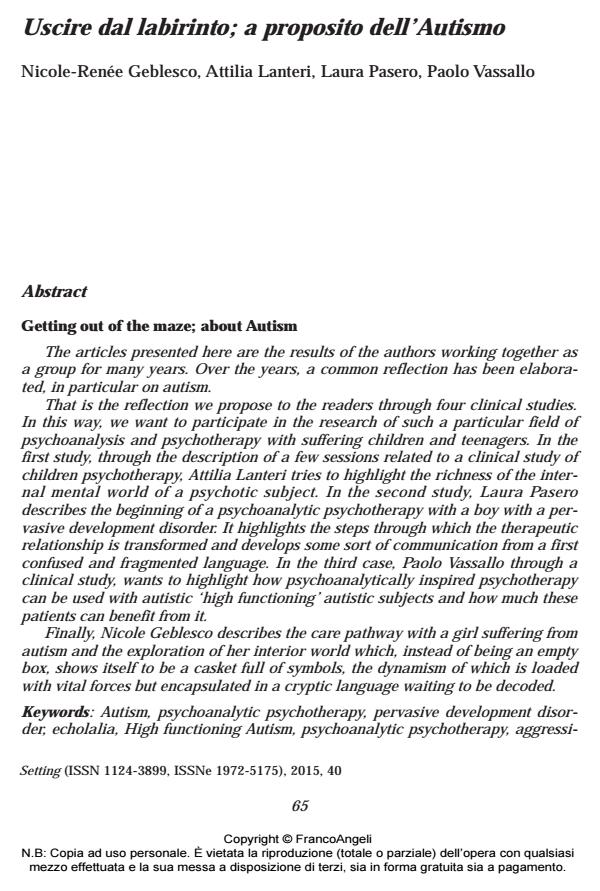Getting out of the maze; about Autism
Journal title SETTING
Author/s Nicole-Renée Geblesco, Attilia Lanteri, Laura Pasero, Paolo Vassallo
Publishing Year 2017 Issue 2015/40
Language Italian Pages 36 P. 65-100 File size 487 KB
DOI 10.3280/SET2015-040002
DOI is like a bar code for intellectual property: to have more infomation
click here
Below, you can see the article first page
If you want to buy this article in PDF format, you can do it, following the instructions to buy download credits

FrancoAngeli is member of Publishers International Linking Association, Inc (PILA), a not-for-profit association which run the CrossRef service enabling links to and from online scholarly content.
The articles presented here are the results of the authors working together as a group for many years. Over the years, a common reflection has been elaborated, in particular on autism. That is the reflection we propose to the readers through four clinical studies. In this way, we want to participate in the research of such a particular field of psychoanalysis and psychotherapy with suffering children and teenagers. In the first study, through the description of a few sessions related to a clinical study of children psychotherapy, Attilia Lanteri tries to highlight the richness of the internal mental world of a psychotic subject. In the second study, Laura Pasero describes the beginning of a psychoanalytic psychotherapy with a boy with a pervasive development disorder. It highlights the steps through which the therapeutic relationship is transformed and develops some sort of communication from a first confused and fragmented language. In the third case, Paolo Vassallo through a clinical study, wants to highlight how psychoanalytically inspired psychotherapy can be used with autistic ‘high functioning’ autistic subjects and how much these patients can benefit from it. Finally, Nicole Geblesco describes the care pathway with a girl suffering from autism and the exploration of her interior world which, instead of being an empty box, shows itself to be a casket full of symbols, the dynamism of which is loaded with vital forces but encapsulated in a cryptic language waiting to be decoded.
Keywords: Autism, psychoanalytic psychotherapy, pervasive development disorder, echolalia, High functioning Autism, psychoanalytic psychotherapy, aggressive and libidinal drive, symbolic thought, empty box, syntactic assembly, symbiosis, triangulation, Autonomous Thinking, depressive situation.
Nicole-Renée Geblesco, Attilia Lanteri, Laura Pasero, Paolo Vassallo, Uscire dal labirinto; a proposito dell’Autismo in "SETTING" 40/2015, pp 65-100, DOI: 10.3280/SET2015-040002